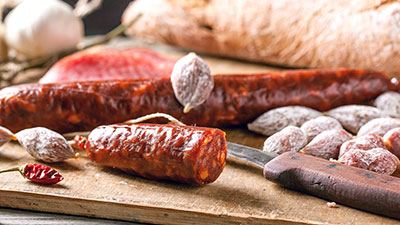Meats and Sausages
Chorizo Cántabro (Guriezo)
Chorizo Cántabro is a Basque chorizo popular in Cantabria, an autonomous region on Spain’s north coast. The sausage is made with the “choricero pepper” (pimiento choricero), a variety of red pepper (a variant of the species Capsicum annuum) that is usually dried in the air in strings to preserve it better. Chorizo Cántabro is also known as Chorizo de Guriezo. Guriezo is a municipality located in the autonomous community of Cantabria, Spain.
| Meats | Metric | US |
|---|---|---|
| Pork, lean | 600 g | 1.32 lb |
| Pork belly | 400 g | 0.88 lb |
Ingredients per 1000g (1 kg) of meat
| Salt | 21 g | 3.5 tsp |
| Cure #1* | 2.5 g | ½ tsp |
| Dextrose | 2.0 g | 1/2 tsp |
| Sugar | 2.0 g | 1/2 tsp |
| Chorizo pepper** | 6.0 g | 3 tsp |
| Pimentón, hot | 2.0 g | 1/2 tsp |
| Garlic | 7.0 g | 2 cloves |
Instructions
- Grind meat and belly through 10 mm (3/8”) plate.
- Mix with all spices. Hold the mixture for 12 hours in refrigerator.
- Stuff into 32-36 mm hog casings forming links, Tie the ends together.
- Apply a thin cold smoke and dry at 18° C (64° F) for 2 days. Cold smoking does not have to be a continuous process.
- Dry sausages for 14 days at 12-15° C (53-59° F), 75-80% humidity.
Notes
Sausage can be consumed raw, fried or cooked in white wine or cider.
* In US the chorizo pepper (Choricero) can be ordered from Edwards Greenhouse, Boise, ID https://www.edwardsgreenhouse.com
It is a common practice in northern Spain to cook (simmer) chorizos in white wine. Cook them whole or cut into 7-10 cm (3-4”) pieces and heat in wine for 30 minutes. Fat will leak into the wine, pimentón will color the liquid red and the sausage is enjoyed with soaked in wine bread.
* In US the chorizo pepper (Choricero) can be ordered from Edwards Greenhouse, Boise, ID https://www.edwardsgreenhouse.com
It is a common practice in northern Spain to cook (simmer) chorizos in white wine. Cook them whole or cut into 7-10 cm (3-4”) pieces and heat in wine for 30 minutes. Fat will leak into the wine, pimentón will color the liquid red and the sausage is enjoyed with soaked in wine bread.


















